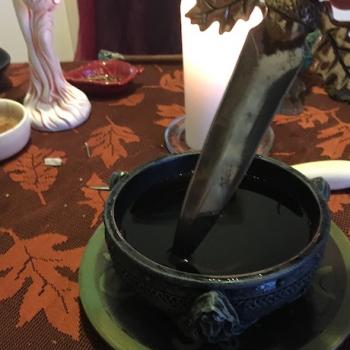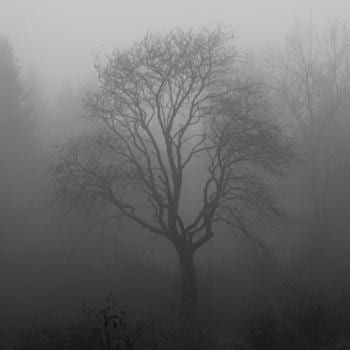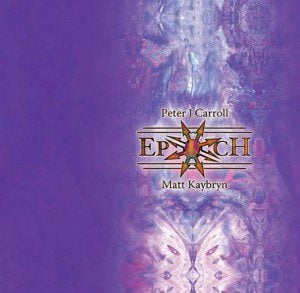 My first exposure to Peter J. Carroll was back in the mid to late 90’s when a roommate of mine was obsessed with Liber Null & Psychonaut: An Introduction to Chaos Magic. My old roommate wasn’t alone in his obsession either — lots of Modern Pagans are big fans of Carroll’s work. In the process of putting this interview together, I got to know Carroll as “Pete,” but he’ll always be Mr. Carroll to me.
My first exposure to Peter J. Carroll was back in the mid to late 90’s when a roommate of mine was obsessed with Liber Null & Psychonaut: An Introduction to Chaos Magic. My old roommate wasn’t alone in his obsession either — lots of Modern Pagans are big fans of Carroll’s work. In the process of putting this interview together, I got to know Carroll as “Pete,” but he’ll always be Mr. Carroll to me.
Jason: You have a lot of projects going on right now, but let’s start with Epoch, your latest book. It’s a combination of history, magic, philosophy and art (much of it by artist Matt Kaybryn). How did this project get started?
Peter J. Carroll: I first met Matt through Arcanorium College, and he offered to do some illustrations for my book The Octavo that I had in preparation at the time. After exchanging ideas, Matt came over to visit, his artistic skills experience impressed me greatly and we got on very well personally, so we soon started plotting a mutual adventure. I never really stop writing thoughts and results up, and for a long time I’d felt the Muse moving me towards doing something Chaoist /Neo-Pagan with the idea of moveable images on cards, and something on the Cthulhu / Necronomicon Mythos. Matt’s presence made all this suddenly possible and we developed it over the following several years in the course of thousands of exchanges on Arcanorium College augmented by a visit from Matt to the UK each summer. Plus I started meeting Professor Ronald Hutton regularly and he kindly gave me a lot of great references and scholarly criticism on the historical material.
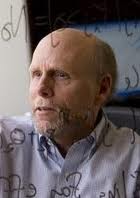 Epoch touches on a lot of different subjects, and should appeal to a broad range of folks. Were you writing for a particular audience?
Epoch touches on a lot of different subjects, and should appeal to a broad range of folks. Were you writing for a particular audience?
It may sound odd but I always write for myself. By that I mean that I write primarily to organise ideas to my own satisfaction. I don’t rely on writing to make a living, so I can explore whatever interests me. If others find the material of use and interest well great; but I’d still do it anyway. I would hope that anyone with an interest in magic, esoterics, religion, off-piste science, and philosophy will find plenty of surprising material in it; I certainly had plenty of minor and major epiphanies during its creation.
The book begins with a lot of history, and it’s history generally ignored or overlooked in many magical and Modern Pagan type books. One of the terms you use early in the book is Platonic Pagan Monotheism (PPM).
Surprising as it may seem, the core ideas of western esotericism remained virtually unchanged from their formative period in the first and second centuries AD until the twentieth century. In the first and second centuries Greek Platonism, Classical Paganism, and Hebraically inspired Monotheism clashed in a great metaphysical, religious, esoteric, and psychological upheaval. Hermetics, Gnosticism, and Kabala all originate in this period and they all partake of varying elements of Platonic and Neo-Platonic Idealism, varying elements of Pagan Polytheism, and varying elements of Monotheist Transcendentalism. These three currents of thought dominated the western esoteric paradigm for the next eighteen centuries.
There’s another term you use in the book that I found memorable, “Quantum Neo-Pagan.” Can you share what you mean by that term with my readers?
Today the classical ‘spirit’ hypotheses and the nineteenth century ‘energy’ hypotheses seem inadequate to explain magical, parapsychological, and religious phenomena. Instead we need to reframe the models in terms of information and memes, and miracles in terms of non-local information exchange, which works by quantum mechanisms.
The vast majority of contemporary Pagans qualify as Neo-Pagans. They take only what they want from the past, the symbolism, the archetypes, and the freedom to innovate. Animal sacrifice and other unpleasant mandatory features of traditional paganism do not apply.
I’ve always enjoyed how forthright you are in your writing. Early in the book you lay into mundane astrology (such as general horoscopes), citing it as an unnecessary complication to the practice of magic. I know so many people who swear by mundane astrology. Are those individuals ruining their magical practice by focusing too much on planetary alignments and other things of that nature?
Mundane or calendrical astrology has considerable predictive power when it comes to things like the timing of sowing or harvesting, or going to war, or the outcomes of time of the year in which conception or birth occurs. Moon cycles also have measurable effects on living organisms including us. However beyond that it all gets ridiculously complicated and the predictive power drops so close to zero that statisticians usually discount it. Yet if people feel more confident launching spells or rituals at certain ‘appropriate’ astrological moments then good luck to them, but it doesn’t constrain me.
 In your overview of magical history in the book, you write about Samuel L. MacGregor Mathers as a sort of seminal magical figure (to me it even felt like you were articulating the idea that he might have been some sort of nexus for the coming together of several magical streams). I completely agree with you, but outside of a few circles Mathers mostly feels overlooked; when he’s written about at all, it’s only within the context of the Golden Dawn. How important do you think Mathers has been in the development of modern magic and why is he so often overlooked?
In your overview of magical history in the book, you write about Samuel L. MacGregor Mathers as a sort of seminal magical figure (to me it even felt like you were articulating the idea that he might have been some sort of nexus for the coming together of several magical streams). I completely agree with you, but outside of a few circles Mathers mostly feels overlooked; when he’s written about at all, it’s only within the context of the Golden Dawn. How important do you think Mathers has been in the development of modern magic and why is he so often overlooked?
Mathers did not present himself as a loud or notorious figure like Crowley, but Mathers’ astonishing scholarship and leadership underlies the esoteric revival that began in the 1880s and gave birth to the modern forms of Theosophy, Druidry, Neo-Paganism & Wicca, Hermetics, and Thelema. He influenced everyone involved in the formation of those traditions. By drawing together and organizing and translating and publishing many scattered strands of knowledge which often lay buried in academic libraries he seems to have more or less single-handedly provided the basic toolkit for the entire revival. He wrote Liber 777, the core document which provides a scheme that more or less integrates all western esoteric ideas and from which so many have borrowed at first, second, or third hand. Crowley however ‘borrowed’ it and published it first.
You seem to have a love/hate relationship with Aleister Crowley. He’s quoted extensively in the book, and yet you also seem to disagree with him on a great many issues. What is your relationship and opinion in regards to The Great Beast?
Well yes, there seems much to admire and much to despise about the man. As Gerald Yorke said to my old friend Gerald Suster decades ago, ‘I don’t know why you young alternative types adore Crowley; you would not have liked him if you had met him.’ His primary interests in other people seemed to revolve around gaining their worship, their wallet, and their sexual submission. He thus appears as a rather sociopathic guru and bully. On the other hand he had many brilliant things to say about magic and mysticism and he pursued his life’s quests with fearless determination and persistence. I consider the so called Book of the Law as my least favourite of his creations; maybe he just had a bad day.
In Modern Pagandom, there often seems to be real disappointment among certain individuals when myths such as the ancient origin of the Tarot are shot down. In the book you write, “such misappropriation of the mundane for magical purposes has always characterized magic at its creative best.” I thought that was a great line, but more importantly, do those of us who acknowledge such historical truths have an edge over those living in an historical fantasy land?
Throughout history humans have made up religions and myths and mythologies and then pretended that they didn’t because they think they will get more mileage out of them that way. I disagree. I have more confidence in a tool if I know precisely where and when and by whom and for what purpose it got made.
In just a few sentences, you were able to easily explain the differences between invoke and evoke. Why do so many Magicians and Neo-Pagans have trouble defining these words?
The dictionary distinction between these terms remains unclear as does popular usage. Eliphas Levi seems the first to have tried to establish an esoteric distinction and I more or less followed his lead with Invocation defined as calling something ‘into’ or ‘up from within’ yourself that has broad super-human attributes like a god-form such as Zeus or Kali. Evocation then means calling up somewhat lesser entities with a narrower brief for the purposes of commanding them or communicating with them without entering into personal identification with them or possession by them, as in Invocation.
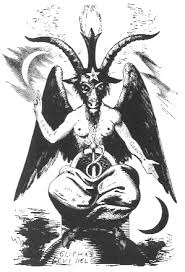 I liked your take and brief history on Baphomet, and I sense a great deal of respect there. I know that in Pagan circles, he’s often a figure that’s shied away from. Is that true in magical circles as well?
I liked your take and brief history on Baphomet, and I sense a great deal of respect there. I know that in Pagan circles, he’s often a figure that’s shied away from. Is that true in magical circles as well?
Following the lead of Eliphas Levi, a number of magicians have taken the view that Baphomet represents the Planetary Egregore of Earth, its geology and all of its life including ours. It can appear a bit demonic and anti-Christian, Levi intended it to methinks, because it includes all the instincts and all the biology and the sex and death that makes us real, as opposed to the otherworldly transcendental views of Christianity. It certainly has much in common with the Neo-Pagan ideal of the great god Pan and latterly with the developing concept of Gaia, the idea that the Planet and its Life has some sort of sentience or panpsychism about it, and deserves our utmost respect.
Much of Epoch is spent discussing various deities (Planetary and Bi-Planetary God-Forms) from a wide range of pantheons (with accompanying illustrations). How did you settle on the fifty-plus different archetypes chosen for this book?
By a long process of argumentation. In most cases we had several candidates, our apologies to those we left out; perhaps a later Epochrypha will get everyone in. The Celtic gods and goddesses did not get in simply because we know so little about them and then only second-hand from classical writers or medieval commentators on older myths. The rich pantheons of the pre-Columbian Americas we did not include either, but interested readers may care to identify their equivalents in the comprehensive Chaobala we have provided.
The images are both beautiful and startling. What was the process for coming up with them? Was it a 50/50 collaboration with (artist) Matt Kaybryn?
Having agreed on the gods and goddesses we wished to depict, we tossed ideas back and forth until we evolved something that satisfied us both. Sometimes we used the images of incarnate magicians known to us as the basis for some of the images. Gigabytes of graphic data flowed from NZ to the UK. I don’t have drawing skills but I made a set of sculptures of the Elder Gods out of modeling compounds to clarify the images needed and Matt used these as the basis for his graphics.
 I liked how you used both traditional deities from antiquity along with more contemporary conceptions of deity. The two newest forces you write about in the book are Apophenia and Pareidolia. Can you share some insight as to how those two forces became a part of this book?
I liked how you used both traditional deities from antiquity along with more contemporary conceptions of deity. The two newest forces you write about in the book are Apophenia and Pareidolia. Can you share some insight as to how those two forces became a part of this book?
These two goddesses appeared in response to the need for more Muses a few years ago. They have existed within the human psyche from its beginnings and I wrote about their influences on how we think and create in The Apophenion. The techniques of Chaos Magic allow them to manifest more fully as actual goddesses with personalities who will respond to Invocation, just like their classical sisters.
A lot of the illustrations in the book show deities in a contemporary setting or with modern technology. My favorite was probably Vulcan with an electric drill and a hammer. Was this a conscious effort to depict the gods as evolving figures?
Yes indeed and I love invoking the Vulcan gnosis and making things, boats, surfboards, furniture, jewellery, statuary, and of course my own swords, wands, and other magical instruments. Matt enlarged the beard a bit to partially conceal the identity of the model but I can tell you that’s no ordinary drill, it’s a customised DEWALT 997, best in its class for light cordless. 🙂
Perhaps they were throw-away moments for you as a writer but there were moments when reading Epoch where I was genuinely surprised by things that should have been obvious to me. You write that Egyptian paganism was “the most benign, humanistic, and sophisticated of all the pagan systems,” pointing out that it lacked animal sacrifice. In retrospect, it’s a fairly obvious truth of history, but I had never thought of Egyptian religion in that sort of light before. Why are such truths of history so often overlooked?
Well the early Egyptology, on which a lot of esoterics and basic history draws, concerned itself more with tomb raiding and trying to make sense of the religion and dynastic lineages. Since then more thorough studies have revealed more about the culture and the lives of the people. The ancient Egyptians had a very fortunate geography, fertile lands fed regularly by the Nile and easily defendable territory. They had peace and leisure in which to create beauty and to enjoy themselves and they wanted that to continue in the afterlife. Contrast that with say the Mayans who had a less benign environment and frequent wars; their iconography mainly depicts ugliness, horror, and violence.
I found the book’s depiction of Horus the most startling, perhaps because the figure looked real in a modern sense: shades, an average looking face and body, etc. How did that image in particular come about?
Well we wanted an image of a part time warrior for this rather than a full time dedicated professional god of war. Thus we showed an image of a guy going out to defend his homeland or homestead out of necessity with whatever equipment he could get hold of. Our model knows a few martial arts but like Horus he hasn’t dedicated his whole life to professional soldiering.
 You don’t pull any punches with your descriptions of the gods. You write about Loki as a “Treacherous Machiavellian Psychopath,” for instance, and urge extreme caution when interacting with him, which is different than simply calling him a “Trickster” and then being on your way. Where do you think the tendency to “pretty up gods” (like Loki) comes from?
You don’t pull any punches with your descriptions of the gods. You write about Loki as a “Treacherous Machiavellian Psychopath,” for instance, and urge extreme caution when interacting with him, which is different than simply calling him a “Trickster” and then being on your way. Where do you think the tendency to “pretty up gods” (like Loki) comes from?
From the Norse Neo-Pagan apologists. I doubt that few of them would actually like to go back to the dark ages for real, rather they prefer to recreate a fantasy version of it without the realities of kill or starve, constant threat of violence and treachery and drowning, septic wounds, bad-ass gods and a doom laden eschatology relieved only by comradeship and plenty of mead.
I was both surprised and overjoyed to see Bob-Legba make your list of deity figures. There’s got to be a story behind that, right?
Yes, we Chaoists take some inspiration from Discordianism and the Church of the Subgenius, and Bob-Dobbs seems like the latest incarnation of the Solar-Mercurial god-form that we love to invoke for tricky and strange but basically well intentioned purposes and who appears in that peculiar syncretism of Catholicism and West African religion as the Voodoo deity Legba.
Beyond J.R. Bob Dobbs and the pagan gods of antiquity, you also include a lot of Judeo-Christian figures. What was your reasoning for this? Do you expect any backlash or think that such inclusions could limit the appeal of the book?
Only two or three I think, but we cannot ignore the fact that Judeo-Christian ideas have made a contribution to western culture as least a great as that made by Hellenic ideas (from the classical Greeks basically). Pagans, Neo-Pagans, and Polytheists object to the Monotheist’s intolerance and their claims to supremacy and exclusivity. In the book I show how and why the Monotheist idea arose and how the monotheist deity arose from and still fits into a sophisticated polytheist scheme. I’m not expecting the more intolerant Monotheists to approve though.
It’s never really spelled out in the book, but I have to assume that the new images included in and created for Epoch are going to be released in a collection for magical purposes.
Oh, most definitely yes. The fifty four cards of The Portals of Chaos deck complement the book and present the images in large format that you can use as altarpieces for works of Invocation, Evocation, Illumination, and Enchantment as well as for Divination.
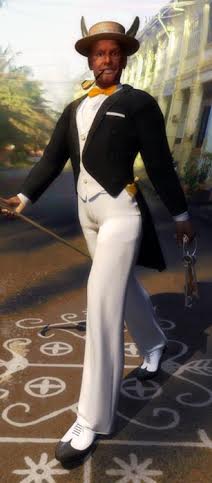 The last third of the book is dedicated to the unveiling of a new magical system based upon the writings of H.P. Lovecraft. How did that come about? What draws you to Lovecraft’s work?
The last third of the book is dedicated to the unveiling of a new magical system based upon the writings of H.P. Lovecraft. How did that come about? What draws you to Lovecraft’s work?
Well it’s not his literary style or his melodramatic prose that’s for sure. However underneath all the gothic murk there lurks a core of radical ideas about what must lie out in the cosmos and in our future, knowledge and power that we will find awesome and also terrible if we mishandle it. He seems to me the prime Mythographer of the possible futures of the human race.
In addition to writing, you are the Chancellor of the Arcanorium College. How involved with the college are you on a day-to-day basis? If someone was interested in signing up for classes what can they expect?
I attend to the online College almost every day, weekends included. At present we have some people giving fairly formal course instructions and many others contributing to ongoing topics and projects and workshops. Participants may initiate topics and discus their own projects.
You’ve been instrumental in developing the theory and practice of Chaos Magic. I find that many Modern Pagans don’t always know exactly what the term means. What’s your definition of it?
It doesn’t really have a neat definition; it consists of a tendency to emphasise certain things like results magic, experimental belief, eclecticism, creativity, laughter, and a sort of gung-ho try it and see if it works attitude towards theory and practise. We freely steal any good ideas and techniques we find lying round and we also make stuff up and try it out. We don’t feel that we have to appeal to deep antiquity to sanctify what we do.
Have you been surprised at just how popular Chaos Magic has become in the last thirty years?
When I sat down in the late seventies and tried to sort out my ideas about magic I sought to work out what made sense to the modern science influenced mind and what still made sense in terms of contemporary beliefs and cultural values, and what this could mean for the future of magical ideas. Thus my only surprise came at those who wished to hang on to those traditional ideas which I had discarded as ineffectual or inappropriate these days.
What do you think your relationship is to Modern Paganism? I know a lot of Pagans who have read your works and been influenced by them, but you aren’t exactly one of us, right?
Ha, well perhaps we have some transatlantic cultural differences here. At the risk of causing uproar I’d classify most British Neo-Pagans as basically atheists or pantheists, they believe in their gods in a mytho-centric rather than a logo-centric way. By this I mean that they believe in them as archetypes which exist primarily in our own heads but which grow stronger and more useful and which can have real effects upon the world and on us if we choose to believe in them. They do not in the main believe that such gods and goddesses have some sort of objective existence as ‘gaseous vertebrates’, or that their myths have literal truth as historical events. Rather the myths represent teaching stories about the human condition.
I feel at home with most Neo- Pagan traditions in the UK and have participated at many varied rituals and meetings. I currently attend a Druid Grove regularly. Of course they all know that Druidry consists of an almost entirely modern synthetic and syncretic ‘tradition’, but that doesn’t inhibit them at all.
You can find out more about Peter Carroll’s latest book (and buy a copy) here. Eventually it will be available through your local independent bookseller, but as of yet, there are no plans for a release on Amazon or any other major retail site. I originally read the book as a PDF, and recently received a hard copy. It was impressive on my computer, but even more so on the printed page. The cards that come with the book are nearly impossible to put down. They have been in my living room the last two weeks and every time we have people over they inevitably pick up the cards and get lost. It’s a pricey package, but a quality one. Very much worth picking up.
Photos:
1. The cover of Epoch.
2. Peter J. Carroll, stolen from wikipedia
3. Samuel Liddell MacGregor Mathers in ritual gear.
4. Baphomet by Levi (not the jeans)
5. Vulcan holding a customised DEWALT 997, best in its class for light cordless.
6. Horus, perhaps not quite ready for war.
7. Bob-Legba, I want this picture blown up and on a wall in my house (pending wife approval).
Images 5-7 are a part of the Portals of Chaos Deck.






